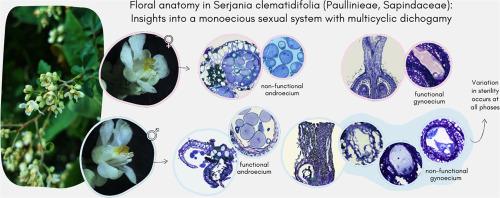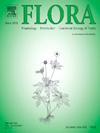Floral anatomy in Serjania clematidifolia (Paullinieae, Sapindaceae): Insights into a monoecious sexual system with multicyclic dichogamy
IF 1.7
4区 生物学
Q3 ECOLOGY
引用次数: 0
Abstract
Serjania clematidifolia Cambess. has a monoecious sexual system with multicyclic dichogamy, i.e., staminate and pistillate flowers are produced in more than three phases. The present study evaluated the flowers in the different flowering phases of the species. For morphometric analyses, flowers were measured and the resulting values statistically analysed. For structural analyses, flowers were processed using standard light microscopy techniques. Serjania clematidifolia has white, unisexual, nectariferous, and zygomorphic monosymmetric flowers. In staminate flowers, the anthers are dehiscent, the endothecial cells have bar thickenings, the septum degenerates, and the stomium ruptures, releasing pollen grains in monads at the binucleate microgametophyte stage. In pistillate flowers, the anthers are indehiscent, the endothecial cells near the connective lack parietal thickening, the septum does not degenerate, the stomium does not rupture, and microgametophytes are not released. Male sterility in pistillate flowers is likely associated with structural changes in the endothecium and failures in the process of programmed cell death (PCD) of anther tissues. In pistillate flowers, the stigma is papillose and moist, and the ovary contains campylotropous, bitegmic ovules with seven-celled megagametophytes. In staminate flowers, the stigma has a non-papillose and non-secretory epidermis. The tissues of the style, ovary, and ovules show various levels of degeneration. Ovules may or may not contain megagametophytes. Female sterility in staminate flowers appears to be associated with failures in megagametophyte differentiation or PCD of its cells. We conclude that in S. clematidifolia, (i) the morphometric variation between staminate and pistillate flowers in different flowering phases does not indicate the existence of distinct floral types, (ii) there are no structural differences between staminate or pistillate flowers from different flowering phases, (iii) megagametophytes may or may not differentiate in ovules of staminate flowers, and (iv) microgametophytes differentiate in indehiscent anthers of pistillate flowers.

Serjania clematidifolia(无患子科)的花卉解剖学:对雌雄同株多环双歧有性系统的启示
Serjania clematidifolia Cambess.为雌雄同株有性系统,具有多环二歧性,即雄花和雌花分三期以上开放。本研究对该物种不同花期的花进行了评估。为了进行形态分析,对花朵进行了测量,并对测量值进行了统计分析。在结构分析方面,使用标准的光学显微镜技术对花朵进行了处理。Serjania clematidifolia 的花朵为白色,单性,有蜜腺,左右对称。在雄花中,花药开裂,内皮细胞有条状增厚,隔膜退化,气孔破裂,在双核小孢子叶阶段释放出单体花粉粒。在雌花中,花药不裂,靠近药隔的内皮细胞没有顶端增厚,药隔不会退化,气孔不会破裂,也不会释放出小孢子囊。雌花的雄性不育可能与内皮层的结构变化和花药组织的程序性细胞死亡(PCD)过程失败有关。在雌花中,柱头呈乳头状且潮湿,子房中含有钟状、咬合胚珠和七细胞巨型子实体。在雄花中,柱头的表皮不具乳突,也不分泌。花柱、子房和胚珠的组织有不同程度的退化。胚珠可能含有也可能不含有巨型子实体。雄花的雌性不育似乎与巨型子实体分化失败或其细胞的 PCD 有关。我们的结论是,在 S. clematidifolia 中,(i) 不同花期的雄花和雌花之间的形态差异并不表明存在不同的花类型,(ii) 不同花期的雄花或雌花之间没有结构差异,(iii) 雄花胚珠中可能分化出巨型石竹目植物,也可能没有,(iv) 雌花不裂花药中分化出微型石竹目植物。
本文章由计算机程序翻译,如有差异,请以英文原文为准。
求助全文
约1分钟内获得全文
求助全文
来源期刊

Flora
生物-植物科学
CiteScore
3.30
自引率
10.50%
发文量
130
审稿时长
54 days
期刊介绍:
FLORA publishes original contributions and review articles on plant structure (morphology and anatomy), plant distribution (incl. phylogeography) and plant functional ecology (ecophysiology, population ecology and population genetics, organismic interactions, community ecology, ecosystem ecology). Manuscripts (both original and review articles) on a single topic can be compiled in Special Issues, for which suggestions are welcome.
FLORA, the scientific botanical journal with the longest uninterrupted publication sequence (since 1818), considers manuscripts in the above areas which appeal a broad scientific and international readership. Manuscripts focused on floristics and vegetation science will only be considered if they exceed the pure descriptive approach and have relevance for interpreting plant morphology, distribution or ecology. Manuscripts whose content is restricted to purely systematic and nomenclature matters, to geobotanical aspects of only local interest, to pure applications in agri-, horti- or silviculture and pharmacology, and experimental studies dealing exclusively with investigations at the cellular and subcellular level will not be accepted. Manuscripts dealing with comparative and evolutionary aspects of morphology, anatomy and development are welcome.
 求助内容:
求助内容: 应助结果提醒方式:
应助结果提醒方式:


